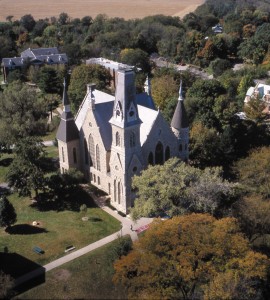The State Historical Society has awarded Cornell College $100,000 challenge grant for the restoration of King Chapel, the iconic 19
th-century building that dominates Mount Vernon’s skyline.

The Historic Site Preservation Grant is set to fund repairs to the chapel’s roof, walls and masonry, including tying together the east and west walls, repointing the attic walls, and replacing roof tiles. While in generally good condition for its age, roof beams that connect the east and west walls have shifted, causing cracks. Those problems also mean the roof tiles, shingles and flashing need to be replaced. The grant requires the college to raise $137,000 to contribute to the project.

“We are pleased to accept the challenge from the State Historical Society and look forward to successfully matching this generous grant,” commented Peter Wilch, Vice President for Alumni and College Advancement. “King Chapel is the icon of our campus and preserving it is an important priority for the college.”
Completed in 1882, King Chapel is at the geographical center of Cornell’s campus, and the central landmark in the Cornell College-Mount Vernon Historic District. For more than 125 years, the college community has gathered in this Victorian gothic building for lectures, concerts, academic ceremonies, and until the 1960s, daily chapel services. It is the unifying visual emblem for Cornell alumni, although the architect Frank Lloyd Wright once derided it as "the most odious example of General Grant gothic."
According to Richard Thomas, chaplain emeritus and professor emeritus of history at Cornell, the award recognizes the importance of King Chapel as a significant historic structure not only to Cornell, but to Linn County and to the state.
“For many years it was the largest auditorium in eastern Iowa and hosted the great artists and scholars of the past 125 years, he said. “It was a center of culture in the changing Iowa frontier. The investment in retaining the historic features of the chapel is a clear encouragement for Cornell to continue to preserve the integrity of its historic campus.”
Cornell’s campus is one of only three in the nation listed in their entirety on the National Register of Historic Places.
King Chapel has played host to many famous names, including President William Howard Taft, Martin Luther King Jr., Ralph Nader, Supreme Court Justice Antonin Scalia, the Dave Brubeck Quartet, Sonny Rollins and John Denver. Today, it provides rehearsal space for musicians and ensembles and more than a dozen concerts, speakers and cultural events.
Cornell was one of 31 applicants for a preservation grant, and one of 12 projects that were funded. The program is to help preserve and restore buildings that promote and understanding of the human experience in Iowa, according to Kristen Vander Molen, grants coordinator for the State Historical Society
The grant is part of a larger, $1.9 million effort to restore and update King Chapel as part of the
Extraordinary Opportunities Campaign. The plans include repairing the tower, replacing the opaque window coverings with clear ones, repairing the stained glass and making the building more accessible to those with disabilities. Extraordinary Opportunities: The Campaign for Cornell College will continue through June 2010. The campaign will enhance the Cornell experience by increasing the college’s endowment, upgrading its facilities, and enhancing the academic program. For more information about the campaign or making a gift, visit
cornellcollege.edu/campaign or contact Peter Wilch at 319-895-4315 or
pwilch@cornellcollege.edu.
Facts about King Chapel:
- King Chapel nearly caused the demise of Cornell College during construction. Crews arrived in 1875, but by mid-1876 when the walls were half erected the contractor went bankrupt. His employees filed liens on the college, a financial burden that proved almost fatal. The entire campus had to be mortgaged and the faculty contributed one quarter of their salaries to help pay off the college's obligations. Happily, conditions improved both nationally and locally so that by 1882 the college was free of debt and the chapel was completed and dedicated.
- The final cost was $72,000 (chapel was paid for three years after the campus was mortgaged in 1877 to pay off chapel debt)
- "Modern" steam heating was installed in 1885 and electric lighting in 1898.
- A radio was installed in 1933 so students could hear the broadcast of F.D. Roosevelt's inauguration.
- It was designed in the Victorian Gothic style by architect Cass Chapman.
- Selected famous speakers:
Martin Luther King, Oct. 15, 1962
Frank Lloyd Wright, early '40s
Former President Taft, 1916
Carl Sandburg (annually from 1920-1939)
Chapel Auditorium's first program, June 22, 1882, by Bishop Matthew Simpson, who addressed the literary societies on leadership. Simpson gave address at Lincoln's funeral.
Ralph Nader (1980)
Supreme Court justice Antonin Scalia (1999)
Gloria Steinem (1999)
Bob Woodward (2004)
- Selected famous performers (most as part of May Music Festival):
Chicago Symphony Orchestra (for 61 years)
Efrem Zimbalist (1917)
Isaac Stern (1949)
Pablo Casals (1923)
Gregor Piatigorsky (1940)
Marilyn Horne (1966)
Dave Brubeck Quartet (1961)
Merce Cunningham Dance Company (1956)
Sonny Rollins (1985)
Bill Evans (1980)
Joe Pass (1978)
John Denver (1980)
 The Historic Site Preservation Grant is set to fund repairs to the chapel’s roof, walls and masonry, including tying together the east and west walls, repointing the attic walls, and replacing roof tiles. While in generally good condition for its age, roof beams that connect the east and west walls have shifted, causing cracks. Those problems also mean the roof tiles, shingles and flashing need to be replaced. The grant requires the college to raise $137,000 to contribute to the project.
The Historic Site Preservation Grant is set to fund repairs to the chapel’s roof, walls and masonry, including tying together the east and west walls, repointing the attic walls, and replacing roof tiles. While in generally good condition for its age, roof beams that connect the east and west walls have shifted, causing cracks. Those problems also mean the roof tiles, shingles and flashing need to be replaced. The grant requires the college to raise $137,000 to contribute to the project.
 “We are pleased to accept the challenge from the State Historical Society and look forward to successfully matching this generous grant,” commented Peter Wilch, Vice President for Alumni and College Advancement. “King Chapel is the icon of our campus and preserving it is an important priority for the college.”
Completed in 1882, King Chapel is at the geographical center of Cornell’s campus, and the central landmark in the Cornell College-Mount Vernon Historic District. For more than 125 years, the college community has gathered in this Victorian gothic building for lectures, concerts, academic ceremonies, and until the 1960s, daily chapel services. It is the unifying visual emblem for Cornell alumni, although the architect Frank Lloyd Wright once derided it as "the most odious example of General Grant gothic."
According to Richard Thomas, chaplain emeritus and professor emeritus of history at Cornell, the award recognizes the importance of King Chapel as a significant historic structure not only to Cornell, but to Linn County and to the state.
“For many years it was the largest auditorium in eastern Iowa and hosted the great artists and scholars of the past 125 years, he said. “It was a center of culture in the changing Iowa frontier. The investment in retaining the historic features of the chapel is a clear encouragement for Cornell to continue to preserve the integrity of its historic campus.”
Cornell’s campus is one of only three in the nation listed in their entirety on the National Register of Historic Places.
King Chapel has played host to many famous names, including President William Howard Taft, Martin Luther King Jr., Ralph Nader, Supreme Court Justice Antonin Scalia, the Dave Brubeck Quartet, Sonny Rollins and John Denver. Today, it provides rehearsal space for musicians and ensembles and more than a dozen concerts, speakers and cultural events.
Cornell was one of 31 applicants for a preservation grant, and one of 12 projects that were funded. The program is to help preserve and restore buildings that promote and understanding of the human experience in Iowa, according to Kristen Vander Molen, grants coordinator for the State Historical Society
The grant is part of a larger, $1.9 million effort to restore and update King Chapel as part of the Extraordinary Opportunities Campaign. The plans include repairing the tower, replacing the opaque window coverings with clear ones, repairing the stained glass and making the building more accessible to those with disabilities. Extraordinary Opportunities: The Campaign for Cornell College will continue through June 2010. The campaign will enhance the Cornell experience by increasing the college’s endowment, upgrading its facilities, and enhancing the academic program. For more information about the campaign or making a gift, visit cornellcollege.edu/campaign or contact Peter Wilch at 319-895-4315 or pwilch@cornellcollege.edu.
Facts about King Chapel:
“We are pleased to accept the challenge from the State Historical Society and look forward to successfully matching this generous grant,” commented Peter Wilch, Vice President for Alumni and College Advancement. “King Chapel is the icon of our campus and preserving it is an important priority for the college.”
Completed in 1882, King Chapel is at the geographical center of Cornell’s campus, and the central landmark in the Cornell College-Mount Vernon Historic District. For more than 125 years, the college community has gathered in this Victorian gothic building for lectures, concerts, academic ceremonies, and until the 1960s, daily chapel services. It is the unifying visual emblem for Cornell alumni, although the architect Frank Lloyd Wright once derided it as "the most odious example of General Grant gothic."
According to Richard Thomas, chaplain emeritus and professor emeritus of history at Cornell, the award recognizes the importance of King Chapel as a significant historic structure not only to Cornell, but to Linn County and to the state.
“For many years it was the largest auditorium in eastern Iowa and hosted the great artists and scholars of the past 125 years, he said. “It was a center of culture in the changing Iowa frontier. The investment in retaining the historic features of the chapel is a clear encouragement for Cornell to continue to preserve the integrity of its historic campus.”
Cornell’s campus is one of only three in the nation listed in their entirety on the National Register of Historic Places.
King Chapel has played host to many famous names, including President William Howard Taft, Martin Luther King Jr., Ralph Nader, Supreme Court Justice Antonin Scalia, the Dave Brubeck Quartet, Sonny Rollins and John Denver. Today, it provides rehearsal space for musicians and ensembles and more than a dozen concerts, speakers and cultural events.
Cornell was one of 31 applicants for a preservation grant, and one of 12 projects that were funded. The program is to help preserve and restore buildings that promote and understanding of the human experience in Iowa, according to Kristen Vander Molen, grants coordinator for the State Historical Society
The grant is part of a larger, $1.9 million effort to restore and update King Chapel as part of the Extraordinary Opportunities Campaign. The plans include repairing the tower, replacing the opaque window coverings with clear ones, repairing the stained glass and making the building more accessible to those with disabilities. Extraordinary Opportunities: The Campaign for Cornell College will continue through June 2010. The campaign will enhance the Cornell experience by increasing the college’s endowment, upgrading its facilities, and enhancing the academic program. For more information about the campaign or making a gift, visit cornellcollege.edu/campaign or contact Peter Wilch at 319-895-4315 or pwilch@cornellcollege.edu.
Facts about King Chapel: